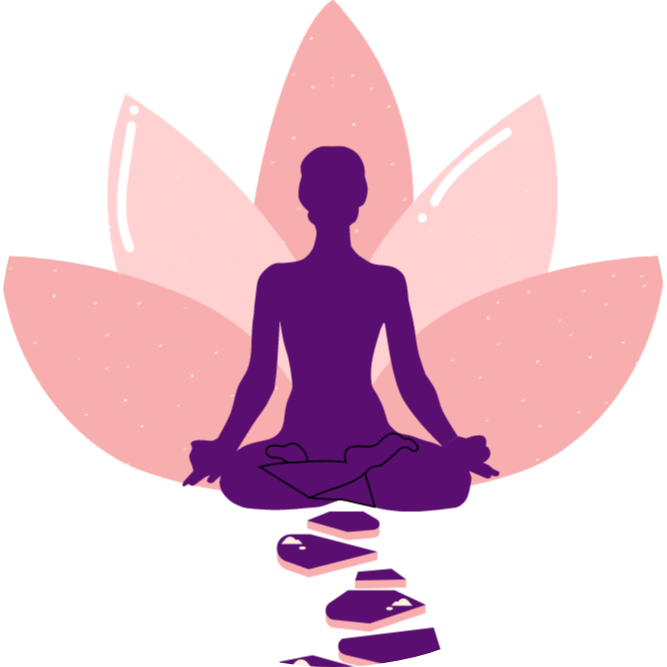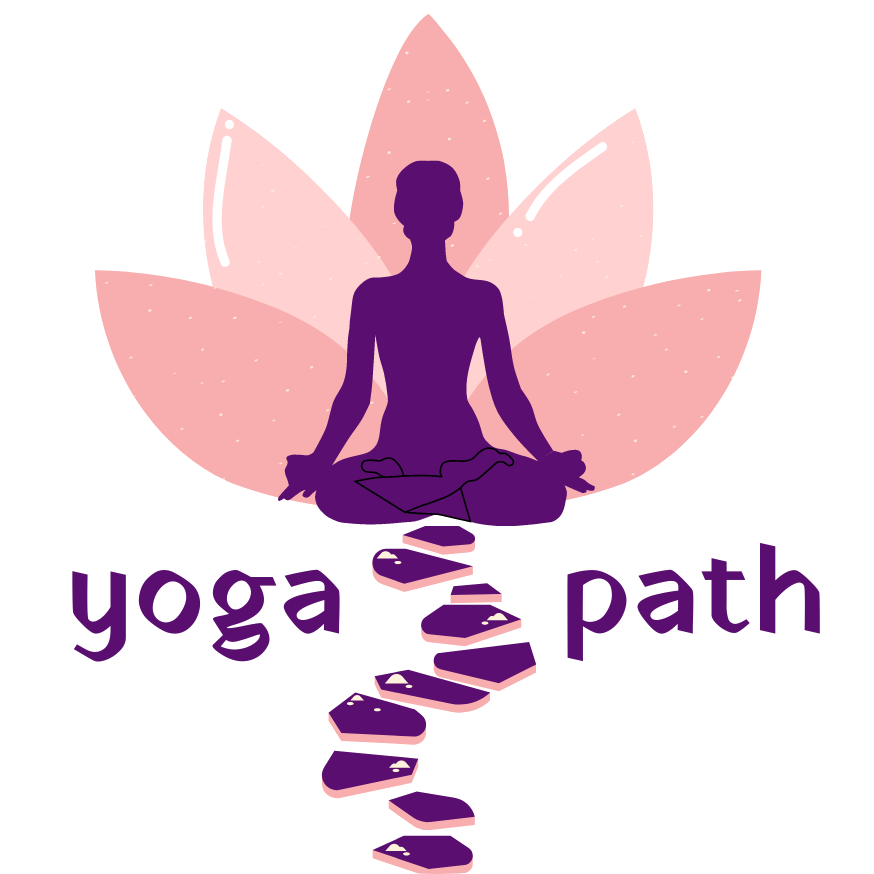Heal PCOS with Yoga
ASANAS FOR PCOS & PCOD
Suffering from PCOS / PCOD?
Heal with yoga.
Polycystic ovary syndrome (PCOS) affects 6 to 12 percent of women during their childbearing years, according to the Centers for Disease Control and Prevention.
Practicing yoga helps decrease testosterone levels, and regulate insulin and progesterone, which in turn greatly alleviates symptoms of anxiety, depression and other symptoms in women with PCOS.
Yoga helps open up the pelvic area, improves circulation, provides a massage in the abdominal area, releases deeply stored stress and promotes relaxation of the mind and body. Women can de-stress and help detoxify their body by practising these asanas regularly.
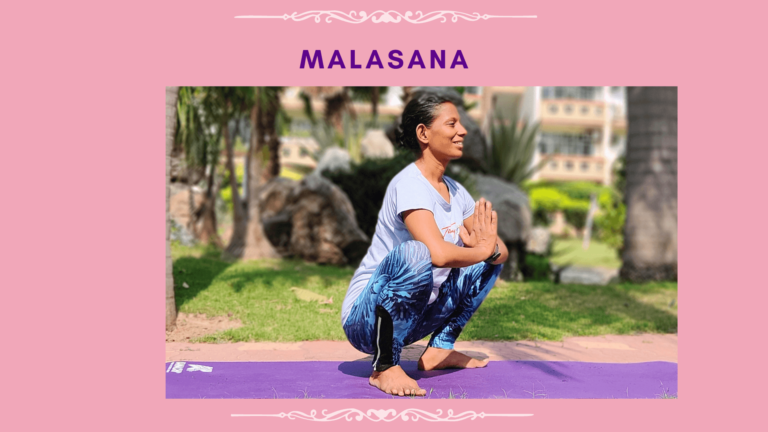
Sitting Position
Malasana meaning Garland Pose
In this asana, squat with your feet as close together as possible. Keep your heels on the floor if you can; or support them on a folded mat.
Open out your thighs slightly wider than your torso. Exhaling, lean your torso forward and fit your elbows snugly between your thighs.
Press your elbows against your inner knees, bringing your palms together in Anjali Mudra (Namaste) – this will help lengthen your front torso.
Hold the position for 30 seconds to 1 minute, then inhale, straighten the knees, and stand up.
Benefits:
Strengthens pelvic floor Increases circulation to the pelvic region benefiting those suffering from PCOS – this mostly on the legs, especially on the hips and thighs Enhances the flow of blood and ensures good elasticity in your hips, thighs, groin and ankles Opens hip flexibility and strengthens leg muscles and increases flexibility Tones the abdominal muscles and improves the function of Colon to help with the elimination of waste Increases circulation and blood flow in the pelvis helping in regulating hormones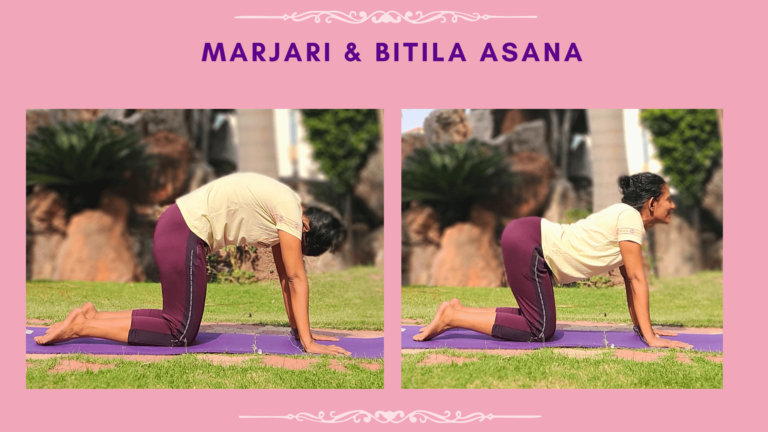
Forward Bend & Backward Bend
Marjari meaning Cat, Bitila meaning Cow
In this asana, sit in Vajrasana then come on all fours or table top with with knees and palms on the floor. The palms are at shoulder distance on the floor also the knees and feet are at hip distance apart. The palms are directly under the shoulder with arm perpendicular to the floor and the knees are under the hips. Look straight ahead. As you inhale, raise your chin, tilt your head and chest back pushing the palms firmly into ground push your navel downwards and raise your tailbone. Hold this cat pose and take long, deep breaths.
Follow this by Bitilasana, a counter pose: As you exhale, drop your chin to your chest and arch your back up as much as you can; pull in the pelvic and chest to form a curve in the spine. Hold this pose for a few seconds.
Contraindications:
Weak wrists injury or surgery to wrists
Shoulder injury back injury
Weak or injured knee – use padding under knees
Benefits:
Brings flexibility to the spine
Stretches the back and relaxes it
Stretches the scapula out and in and increases mobility
Strengthens lower back
Strengthens wrists and shoulders
Massages the digestive organs and improves digestion
Tones the abdomen
Relaxes the mind
Relieves menstrual pain
Improves focus
Improves blood circulation
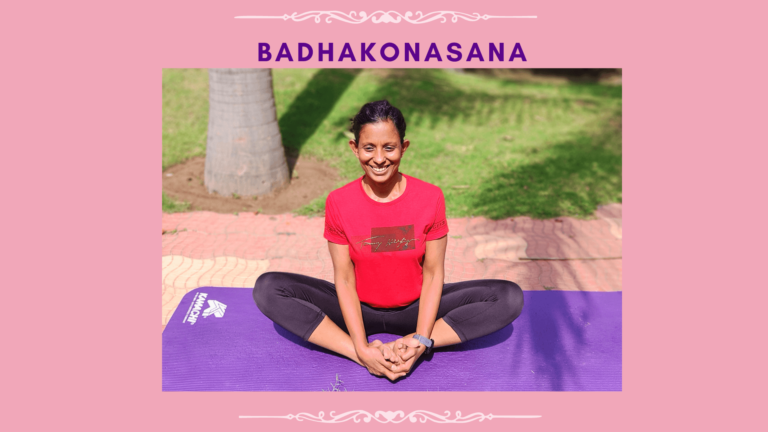
Sitting Posture
Badhakonasana is Butterfly Pose
Sit on the mat with the legs fully stretched forward, toes together – pointing upwards in Dandasana.
Keep the hands beside the body, palms resting on mat.
Inhaling, in 3 seconds, draw both the legs close to the body, with the knees bent outward and the soles of the feet coming together.
Bring the the heels touching each other close to the perineum.
If required, clasp the feet to bring the heels as close to the body as possible.
Now, place the hands on the respective knees pressing them down. Keep the upper part of the body and the neck erect. Hold this pose for 6 seconds.
Exhaling, in 3 seconds, slowly stretch out the legs in front. Practice 3 – 4 rounds.
You can hold the pose for 1 minute and increase slowly. If your legs feel numb or start feeling discomfort, gently release the posture.
Contraindications:
Severe Arthritis and Knee injury
Benefits:
Increases flexibility in joints and in the muscles of the pelvis, knees and ankles.
Stretches both the superficial and deep muscles of the inner side of the thighs.
The interior of pelvis, groin and reproductive organs are stimulated and benefitted.
Those suffering from PCOS are benefitted
urogenital region and groin region receive good circulation.
Relieves tension in the sacral and coccygeal regions of the spine.
Relief in cases of sciatica, varicose vein and menstrual disorders.
Improves posture and concentration–mind remains focused and relaxed.
It opens your hips flexibility and strengthens your leg muscles and increases flexibility.
Ushtrasana
Sitting Position – Backward Bend
Ushtrasana meaning Camel Pose
Sit in Vajrasana then come into a kneeling position on the mat.
Slowly, lean backwards, and take the arms behind.
Place the palms on the heels.
Keep the arms straight, inhaling in 3 seconds, slowly lift the pelvis and chest upward and outward. Allow the neck to fall backwards gently. Slowly maintain the final position for 30 seconds to 1 minute. Breathing should be normal – slow and rhythmic. Exhaling, in 3 seconds, gently draw back the torso and straighten the neck. Releasing the palm, come back to kneeling position. Practice 2 rounds.
Contraindications:
Abdominal inflammations, Ulcers and Slip Disc
Benefits:
Stretches back shoulder and neck.
Stretches thighs, abdomen, thorax, neck and facial muscles.
Alleviates constipation.
Relieves back pain.
Improves posture by correcting drooping shoulders and rounded back.
Improves breathing by opening up the chest; hence, good for asthmatics.
Stimulates and regulates ovaries, thyroid and other glands.
Improves stamina and self esteem.
Bhujanga Asana
Prone Position – Back Bend
Bhujanga Asana meaning Cobra Pose, is also a part of the Surya Namaskar (salute to the sun)
Lie down on your abdomen with your toes flat on the floor, soles facing upwards; rest your forehead on the ground. Keep your legs close together, with your feet and heels lightly touching each other. Place both palms beside the chest elbows should be bent and close to your torso.
As you inhale slowly lift your head, chest and upper part of abdomen. Keep your navel on the floor. Keep elbows close to body.
Keep breathing with awareness, as you curve your spine upward vertebra .by vertebra look straight ahead. Maintain this pose for a few seconds while breathing evenly for 4-5 breaths.
Now, breathe out, and gently bring your abdomen, chest, and head back to the floor and relax.
Contraindications:
Hernia, Hypertension, Heart Ailments, Pregnancy, Peptic ulcer and Hyper thyroid
Benefits:
Helps align vertebra
Strengthens Muscles of Back and spine and keeps spine flexible
Relief from back pain
Stimulates spinal nerves
Tones abdominal muscles And organs
Alleviates constipation
Stimulates appetite
Prevents diseases by aiding in elimination through intra abdominal pressure
Relief from flatulence
Helps resolving slipped disc
Relief in Ankylosing Spondylitis and kyphosis
Helps in menstrual and gynaecological disorders
Strengthens willpower alertness and increases determination
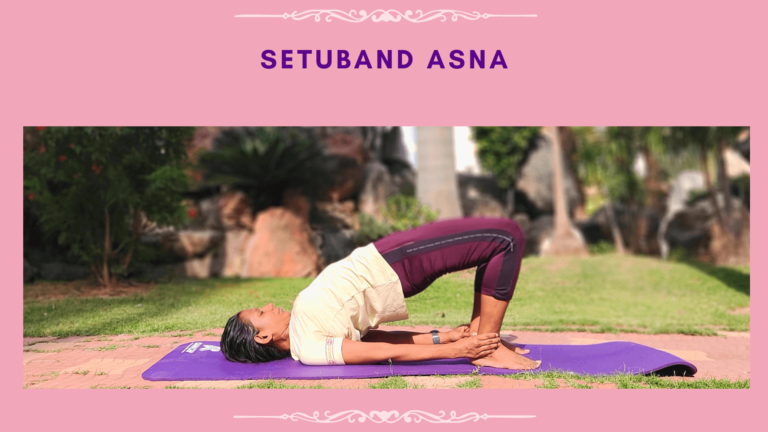
Supine Asana
Setu meaning Bridge; Bandha meaning Bind or Lock;
To begin, lie on your back. Fold your knees and keep your feet hip distance apart on the floor, close to your pelvis, with knees and ankles in a straight line.
Place your palms on your ankles. Inhaling, slowly lift your lower back, middle back and upper back off the floor; gently roll the shoulders inwards; raise the chest to the chin supporting your weight with your shoulders, arms and feet.
Both the thighs are parallel to each other and to the floor. Hold this pose for few breaths. exhale as you gently release the pose.
Contraindications:
Neck injuries, Shoulder or back injuries or surgery, Hypertension, Heart ailments, Myopia and Glaucoma or retinal detachment.
Benefits:
Strengthens the back muscles
Relaxes back instantaneously
Gives a good stretch to the chest, neck and spine
Opens up the lungs and reduces thyroid problems
Strengthens glutes and quadriceps
Calms the brain, reducing anxiety, stress and depression
Helps improve digestion
Helps relieve the symptoms of menopause and menstrual pain
Helpful in asthma, high blood pressure, osteoporosis, and sinusitis
Shalabasana
Prone Pose – Backward Bend
Shalabasana means Locust Pose
Lie on the stomach (prone position), with chin resting on the mat, legs stretched out–toes pointing outwards. Rest the arms by the sides, palms facing up, slightly.
pushed under the thighs. Exhaling, in 3 seconds, raise the right leg as high as possible lifting from thighs contracting lower back and glute muscles without lifting the hips; the left leg is firmly on the ground.
Maintain this pose for 6 seconds
To return to starting position, inhaling, in 3 seconds, gently bring the raised foot down to attain starting position.
Follow same with left leg. Now, perform the Asana with both the legs rising simultaneously, while exhaling to complete 1 round.
Practice 3 rounds.
Contraindications:
Hernia, Hyper tension, Heart ailments, Pregnancy and Peptic ulcers. People with a protruding belly will have difficulty lying in prone position.
Benefits:
Strengthens the lower back, pelvic organs, legs, hip joints and arms.
Tones the sciatic nerves.
Provide relief in backache, mild sciatica and slipped disc.
Alleviates unfavourable conditions of diseases of the stomach and bowels.
Stimulates the kidneys, liver and all the organs of the lower part of the body.
Increases abdominal pressure, regulating intestinal function and stimulating the abdominal organs.
Stimulates the appetite.
Relief from constipation.
Relieves backache during Menstrual cycles.
Cures cervical spondylitis.
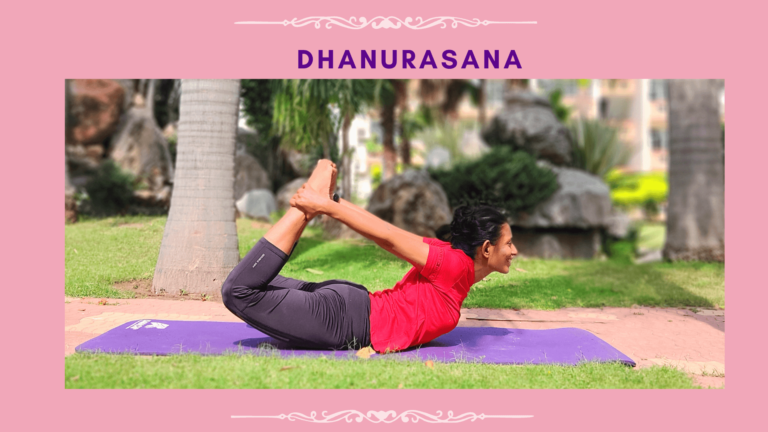
Prone Position / Lying Down Asana
The Asana resembles a bow or dhanusha, hence the name.
Lie on the stomach (prone position), on a mat, legs stretched out straight and feet together with toes pointing outwards.
Slowly, raise the head and the neck and simultaneously bend the legs at the knees. Grasp the ankles of the legs with the respective hands.
Inhaling, in 3 seconds, raise the head upwards, Simultaneously, pull the legs also upwards to give the body a bow shape.
Hold this pose for 6 seconds.
Exhaling, in 3 seconds, bring the head down and simultaneously, release the ankles and unfold the legs.
Remember to raise and lower each vertebrae slowly relieving the spinal pressure by stages. Practice 3 rounds. Hold the final position for 30 seconds and slowly till 2 minutes (start with 30 seconds) – breathing should be normal, slow and rhythmic.
Contraindications:
Hernia, hyper tension, heart ailments, pregnancy, peptic ulcers, serious spinal aliments and osteo-arthritis. People with a protruding belly will have difficulty in assuming a prone position.
Benefits:
Abdominal area gets a very good massage.
The internal abdominal organs and reproductive organs also get a good circulation.
Regulates menstrual cycle.
Stretches to abdominal and pelvic muscles.
Strengthens muscles of thighs and legs.
Stretches the intercostal muscles and improves respiration.
Prevents diseases by aiding elimination through intra- abdominal pressure.
Provides relief from flatulence and indigestion.
Relieves back pain.
Helps in resolving slipped disc.
Helps relieve Ankylosing Spondylitis.
Alleviates constipation and helps in menstrual disorders.
Strengthens the will power by increasing determination and alertness towards precision in functioning.
